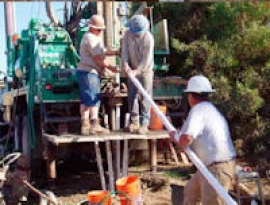By George J. Janczyn
 October 16, 2011 (San Diego) -- The following story is reprinted with permission from http://GrokSurfSanDiego.com.
October 16, 2011 (San Diego) -- The following story is reprinted with permission from http://GrokSurfSanDiego.com.
The United States Geological Survey (USGS), in cooperation with the City of San Diego, will begin installation of the next deep monitoring well site. The drilling and well installation is being done by USGS Research Drilling Unit, which aids USGS scientists throughout the western United States.
WHAT
The next deep monitoring well site in the San Diego area will be drilled to a depth of about 1500 feet, with 4-6 piezometers installed, each to a different depth. Water-level and water-quality information can be obtained from the piezometers. Pressure transducers will be installed to continuously monitor water levels; this real-time data is routed via satellite to a public website. The well site is designed to be a long-term investment for the next 50-100 years. Initially, it will provide information about the local geology and hydrology; later, it can be used to manage groundwater operations.
The well location is at the intersection of Home and Federal streets, just off SR94, just west of Interstate 805. Can’t miss us. Look for the big yellow drill rig with USGS on it. You are welcome to stop by anytime. The well site was chosen to be on the west side of the La Nacion fault, paired with the recently completed Chollas Park well site (SDCP), and about halfway in between the El Toyon (SDEP) and Aquaculture (SDAQ) well sites.
An additional source of water in the San Diego area may come from the San Diego Formation and the overlying, and possibly underlying, sedimentary deposits of sand, silt, and gravel. Prior to the USGS study, which began in 2001, the location, thickness, and water-yielding character of these deposits was poorly known. Since 2001, the USGS has installed 10 deep monitoring well sites throughout the coastal San Diego area; the sites are a key part of creating a three-dimensional view of the San Diego underground. This geologic, water-level, and water-quality information will help guide public agencies and consultants in how to best utilize the limited, mostly brackish, groundwater resources in the coastal San Diego area.
We’ll use mud rotary drilling technique, along with wire-line coring to collect undisturbed samples of sediment from selected depths. The piezometers are mostly 2-inch and one 3-inch PVC pipes which are installed to different depths. Each PVC pipe has 20 feet of perforations at the bottom to allow water to enter the pipe only at that depth. Sand is installed around the perforations and a thick clay-like grout is installed elsewhere. The end result is that we will have a nest of 4-6 PVC pipes that we can measure water levels in, and collect water quality samples from. The 3-inch PVC pipe extends to the bottom of the well bore and allows us to conduct a variety of future measurements, such as identifying changes in salinity throughout the entire 1,500 feet section of aquifer.
Research Hydrologist
United States Geological Survey (USGS)
California Water Science Center
4165 Spruance Road, Suite 200
San Diego, CA 92101 USA
619-225-6100 office
858-663-6832 mobile







Recent comments